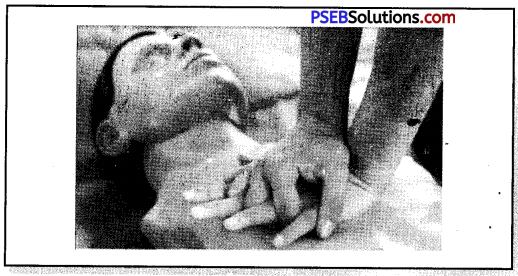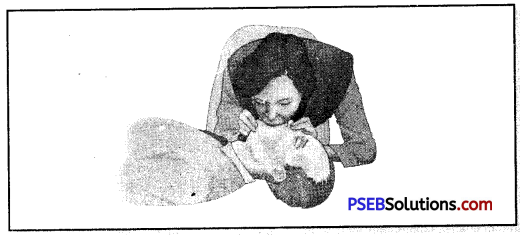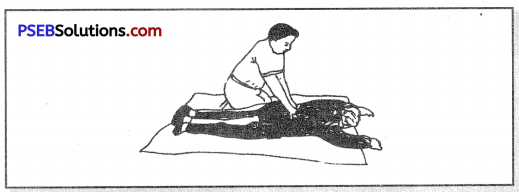Punjab State Board PSEB 9th Class Physical Education Book Solutions Chapter 4 First Aid Textbook Exercise Questions and Answers.
PSEB Solutions for Class 9 Physical Education Chapter 4 First Aid
Very Short Answer Type Questions
Question 1.
What do you know about First Aid?
Answer:
The aid which is given to a patient before arrival to the doctor is known as first aid.
Question 2.
What is Fracture?
Answer:
Breakage in Bone is called Fracture.
Question 3.
What is Unconsciousness?
Answer:
It means to lose consciousness.
![]()
Question 4.
What is Electric Shock?
Answer:
One gets electric shock when touches a live electric wire.
Question 5.
Name any two types of fracture?
Answer:
- Simple fracture
- Multiple fracture.
Question 6.
Complicated Fracture is dangerous. (Right or Wrong)
Answer:
Right.
PSEB 9th Class Physical Education Book Chapter 4 First Aid
Question 7.
Depressed Fracture is harmful. (Right or Wrong)
Answer:
Wrong.
Question 8.
Write any two symptoms of unconciousness.
Answer:
- Pulse becomes very slow
- skin becomes cold.
![]()
Question 9.
What is dislocation?
Answer:
Displacement of bone from the joint is known as Dislocation.
Question 10.
Is there any difference between strain and sprain?
Answer:
Yes, there is a difference.
Short Answer Type Questions
Question 1.
What do you know about First Aid?
Answer:
In our daily life many accidents occur. No wonder we may get injured or wounded on bicycle or in the playfield. Accidents can occur anywhere and anytime at home and outside. It is not possible that doctor may be present at the place of accident. The aid given to the wounded or the patient till the doctor arrives or is approached is called FIRST AID.
![]()
Question 2.
What is strain?
Answer:
Often we hear players say that their muscles are under strain, and so they cannot carry on their game any more. Over work makes the muscles crack, sometimes more and sometimes less. As a result of cracked muscles players feel much pain. Many times that part that has been greatly strained swells.
Question 3.
What is sprain?
Answer:
The player may get sprain:
The feet and the wrists are prone to receive sprains. The ligaments and tissues quickly crack by chance around it. The player feels pain and is unable to take part in the game.
Question 4.
What will you do if you got dislocation of your knee joint while playing Hockey?
Answer:
If I got my knee joint dislocated while playing Hockey, I will get treatment as under:
I will get dressed dislocated joint with plaster. I will try my level best the joint which was dislocated may not have external pressure. I shall use splint to check die movement of the joint.
![]()
Question 5.
What First Aid will you render to a patient of drowning?
Answer:
Treatment of Drowning:
Some people get drowned while crossing, or bathing in rivers, canals or streams. If First Aid is given to a drowned person after taking him out of water, his life may be saved. Such a person should be given First Aid in the following ways:
1. Removing Water from the Belly:
The drowned person should be taken out of water, and lied down with his belly on a pitcher to get water removed from his belly. If the pitcher is not available, he should be lied on belly-side, and toss him upward by holding his waist. This action will remove water from his belly.
2. Making the Patient Wear Dry clothes: Give the patient dry clothes to wear.
3. Keeping the Patient’s Body Warm: Wrap a blanket or sheet round the patient’s body so that his body may remain warm.
4. Administering Artificial Respiration: If the breathing of the drowned man stops, he should be administered artificial respiration.
5. Giving Hot Tea or Coffee: When the patient comes to his senses, he should be given hot tea or coffee to drink.
6. Taking the Patient to the Doctor: If necessary, the patient should be taken to a doctor.
Question 6.
What First Aid will you render to a patient in case of burning?
Answer:
Sometimes a person gets burnt in fire, by hot vessels, chemicals, acid or electric shock. The result is that skin, muscles and tissues are destroyed. Sometimes scalds are caused by very hot tea, milk, coffee or acid. The skin turns red or clothes get stuck up to the body. One feels intolerable pain. Sometimes a person dies as a result of excessive burns.
Treatment:
- The burnt up part should be carefully treated.
- One should not run in case one catches fire. In such case, one should lie down.
- The person whose clothes catch fire should be wrapped with a blanket.
![]()
Question 7.
What do you mean by Electric Shock? How will you treat it?
Answer:
Electric Shock:
One gets electric shock when one touches a live electric wire, or when such a wire accidentally touches any part of his body. Even one’s body may get burnt in the process. One may go unconscious, or may even die of electric shock. If a person gets touch to a live electric wire, the main supply of electricity should be switched off to release him from the wire. If one fails to locate main switch, the following steps may be taken:
1. Using Rubber Gloves and Dry Wood:
The life of a person may be saved by the use of rubber gloves and dry wood in case the power of electricity is up to 500 watts. Electric current does not pass through these things. A moist or metallic thing should not be used.
2. Removing the Plug: If electric wire is coming from a distant place, it should be broken or the plug should be removed.
3. Giving Artificial Respiration: If the electrocuted person is not breathing, he should be administered artificial respiration.
4. Treatment of Scald or Burnt Part: If some part of the patient is scalded or burnt, its treatment should be done.
5. Encouraging the Patient: The patient should be encouraged.
6. Wrapping in a Blanket: The patient should be kept warm in a blanket.
7. Giving Hot Milk or Tea: The patient should be given hot tea or milk to drink.
Question 8.
Describe the various rules of First Aid.
Answer:
Rules of First Aid:
1. Immediate Aid:
First Aid should be given to the injured at the earliest possible. There should be no hesitation or fear in providing First Aid because there is no time in thinking. Immediate decisions have to be taken to save the life of the injured.
2. Artificial Respiration:
If a person is unconscious, and is not breathing, he should be given artificial respiration. A person suffering from heart attack can also be saved by artificial respiration.
3. Sympathetic Attitude:
The injured person gets extremely frightened. So a sympathetic attitude and goodwill prove to be very important. These are beneficial in removing the fear in the mind of the injured.
4. Prevention of Bleeding:
The flow of blood from the injury should be stopped at the earliest as the excessive loss of blood may endanger the life of the injured.
5. Keeping the injured away from the Crowd:
When a person gets involved in an accident, many people come and surround him from all sides. It prevents the flow of fresh air to the injured and the injured also gets frightened and upset. So the steps should be taken to keep the injured away from the crowd, and to provide First Aid at the earliest.
6. Immediate Medical Aid:
The Medical aid should be arranged for the injured immediately. No untrained person should be allowed to use hit and trial methods of treatment.
![]()
Question 9.
Write down the causes, symptoms and treatment of dislocation of joints.
Answer:
Generally, there is a joint dislocation in the field of sports. The displacement of bones is known as dislocation. The displacement generally occurs in the case of bones of shoulders, hips and wrists.
Causes:
- When heavy thing hit fastly to any joints of a person.
- The weight of sports material is too much heavy.
- Hard surface or uneven ground.
- Insufficient warming up of a player.
- Suddenly falling of an athlete.
Symptoms:
- The movement in the joint stops. The joint pains with the slightest of movement.
- The joint pains as well as swelling.
- The bone can be seen protruding at the place of dislocation.
- The shape of the joint also changed.
- There is a feeling of strain in the joint.
Treatment:
- The dislocated joint should not be moved much.
- The bone should be got reset from a competent doctor.
- Icy cold water should be poured on the dislocated joint.
Question 10.
Mention the causes of Fracture, its symptoms and treatment.
Answer:
Causes:
- When a player plays the game with over courage, over joy or under pressure.
- To fall on hard or slippery ground.
- To play on uneven playfields and fall down.
- To play the game without the supervision of an expert.
Symptoms:
- The place of fracture develops swelling.
- The fracture part of the body becomes strengthless.
- The player feels much pain.
- The shape of fracture part also changes.
- The part of the body becomes shapeless.
- A cracking sound is produced when the fractured part is made to move.
Treatment:
- In case of fracture, the fractured part should not be allowed to move.
- The treatment of the fracture should be immediately done as far as possible.
- In case of injury in the fracture, first of all bleeding should be controlled.
- The broken bone should be set with splints and bandage.
- The fractured part should be plastered with the help of a doctor.
![]()
Question 11.
What is unconsciousness? Mention its symptoms and treatment.
Answer:
Unconsciousness means losing of sense
Symptoms:
These are as under-
- Rate of pulse becomes very slow.
- Skin becomes cold.
- The colour of face turns pale.
- Blood pressure becomes low.
Treatment:
- Check up the heart beat and pulse rate of the patient properly.
- The tongue of the patient should not touch the upper part of the wind pipe.
- Peal off the clothes or loosen the clothes of a patient.
- Let the fresh air should come.
- Massage the chest continuously.
- Try to give artificial respiration if needed.
- Patient should not be given anything orally till he gets conscious.
- He may be given hot drink.
- You may make him smell ammonia, spirit or onion.
- The cause of unconsciousness may be removed as early as possible.
Long Answer Type Questions
Question 1.
What are the qualities and duties of First Aider?
Answer:
- A First Aider should be a person who seeks comfort and joy in serving others, and who looks upon his job as his religious duty.
- He should have the maximum knowledge of medical sciences particularly, he should be quite well versed in
- Anatomy and Physiology.
- He should be capable of understanding the nature of injury, and should be properly trained in First Aid.
- He should be a man of genial nature and self-confidence.
- He should be capable of understanding the mental state of the injured.
- He should have patience, devotion and dedication.
- He should be capable of giving First Aid in a very natural, affectionate manner.
- He should be capable of encouraging the injured.
- He should be familiar with all those points which are relevant to providing First Aid.
- All necessary medicines should always be ready for use in his First Aid Box.
- A high academic qualification is not sufficient for a First Aider. He should have developed in him qualities of a man of high moral character.
In order to make the job of First Aid interesting, a First Aider should be a jovial person. His jovial nature will help in establishing a good rapport between him and the person who needs First Aid, but his humour should not be of cheap variety. His personality should be balanced. He should be perfectly capable, healthy and strong from physical, mental, social and psychological point of view.
Duties of First Aider:
- First aider should give First Aid immediately to the patient.
- He should encourage the patient.
- Try to arrange the doctor as early as possible.
- The dress of the patient should be removed or loosened.
- He should help the patient to save his life.
- He should keep the patient in a comfortable position.
- There should not be crowd or noise around the patient.
- In case of continuous bleeding, the main vessels should be pressed.
- The patient must be kept in open air.
- If the accident occurs due to electronic current or gas, he should first switch off electric current or gas.
![]()
Question 2.
Describe the types of Fracture which is the most dangerous fracture.
Answer:
When a bone is broken into two or more parts is known as fracture. Fractures are of seven types which are as under:
1. Simple Fracture: In this type of fracture, there is neither any visible injury on the body nor is there any harm to the muscles. This is known as simple or closed fracture.
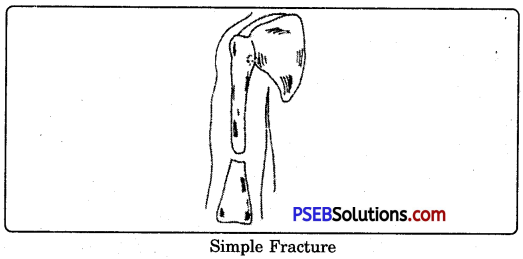
2. Compound Fracture or Open Fracture: In case of Com-pound Fracture, the part of the bone comes out of the skin.
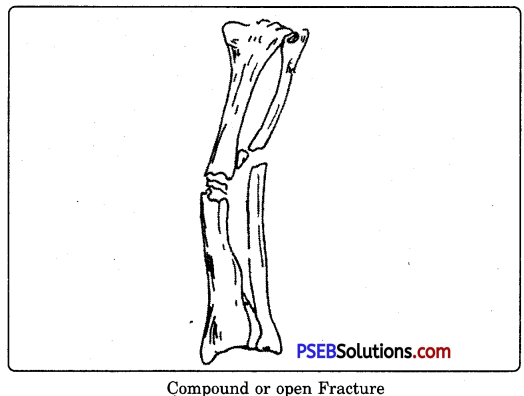
3. Complicated Fracture: In this type of fracture, the internal organs are hurt and affected such as heart, spinal cord, lungs, kidney etc.
4. Commuted Fracture: In commuted fracture, the bones gets broken at many places, and sometimes it is broken Sito pieces.
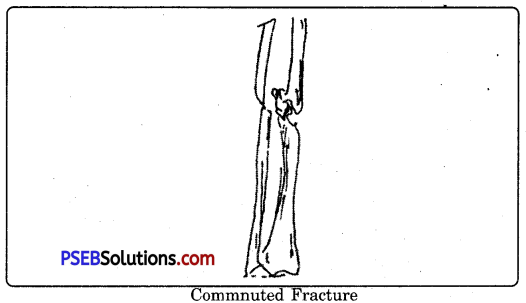
5. Impacted Fracture: In this type of fracture, the broken bones come inside another bone.
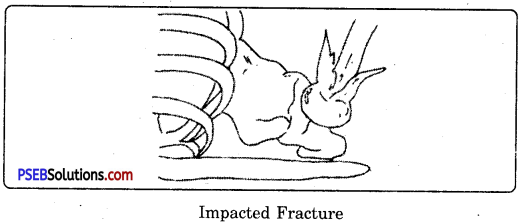
6. Green Stick Fracture: This type of fracture occurs mostly in the young boys of tender age because their bones are very soft and they bend easily. A piece of bones, getting out of the bone, cracks up in this type of fracture.
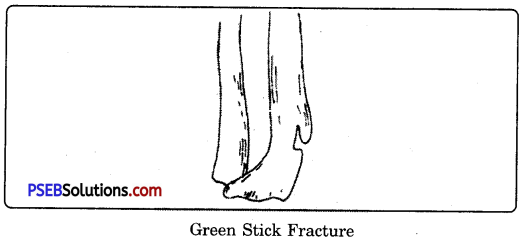
7. Depressed Fracture: This type of fracture occurs in the skull bones. The skull bones gets depressed downward. It is known as depressed fracture.
![]()
Question 3.
What is strain? Describe its causes, symptoms and treatment?
Answer:
Strain:
Often we hear players say that their muscles are under strain, and so they cannot carry on their game any more. Over work makes the muscles crack, sometimes more and sometimes less. As a result of cracked muscles players feel much pain. Many times that part that has been greatly strained swells.
Causes:
- Excess loss of water from the body through sweating.
- More Physical Fatigue.
- Less co-ordination in the parts of the body.
- The hard playground also causes straining of muscles.
- The main cause of strain is insufficient working of a player.
- Bring the weak muscles in action quickly.
- Use of bad types of sports equipments.
- Body is insufficient in strength to bear the load of the activities.
Symptoms:
- Too much tension in muscles.
- Strain parts become unable to do the work.
- Feeling too much pain after getting strain.
- The part of the body seems to be depressed.
- The player may turn blue internally.
- Joint becomes very soft.
Safety Measures:
- The playground should be properly watered, neat and clean. The surface should not be uneven.
- The pitch of High Jump and Long Jump must be kept very soft.
- The students must get safety education.
- The players should be properly warmed up before entering the field.
- Players should not play on wet or slipery place.
- The equipment should be of high standard.
- The players should be cool. They should not take part in games while they are excited.
Treatment:
- The main cause of strain is insufficient warming of a player entering the field.
- The hard playground, too, causes straining of muscles. As such, the playground should be watered off and on.
- The weak muscles crack soon. So one should do exercises to make muscles strong.
- In case muscles are under strain, the player should take rest.
- At first, the strained spot should be cooled down with ice. After 24 hours, it should be fomented by salty hot water.
![]()
Question 4.
What is sprain? Discuss its causes, symptoms and treatment.
Answer:
Sprain:
The player may get sprain. The feet and the wrists are prone to receive sprains. The ligaments and tissues quickly crack by chance around it. The player feels pain and is unable to take part in the game.
Type of Sprain:
Broadly speaking, there are two types of sprain-
1. Ordinary Sprain: In such a case the player gets slight in-jury on the tissue groups that crack, and he does not feel much pain.
2. Heavy Sprain: The player gets hard injury on his tissue group, and feels much pain, and is unable to take part in the game.
Causes:
There may be causes of sprain, some of which are as follows:
- The feet of the player land on uneven place.
- Sometimes the jumping pit is not well dug out.
- Sprain is caused sometimes when the player is not properly warmed up before actual play.
- The weakness of joints.
- The lack of proper coaching.
- A sudden fall while running.
- Sprain may be caused because of inadequate or rough sports equipment such as stud loose boots used in football.
Symptoms:
Whenever a player gets sprain on his joints, he feels pain on the very joint. He is unable to carry on with his game. He feels as if his joint has lost strength and is inflamed.
Treatment:
- When a player gets sprain, he should be called out of the play ground.
- By pouring cold water on the sprained joint or putting some ice on it, the bleeding slows down internally and the swelling also decreases.
- Dressing on the sprained joint also reduces the pain and swelling. Dressing should be done in shape of number 8.
- The sprained joint should be fomented after 48 hours.
- The player should not be allowed to move much.
- Index should be applied after 48 hours on the upper part of the joint. The patient may get some relief and the swelling decreases.
- The sprained joint should be fomented by warm lemon.
Question 5.
Describe the various rules of First Aid.
Answer:
Rules of First Aid:
1. Immediate Aid:
First Aid should be given to the injured at the earliest possible. There should be no hesitation or fear in providing First Aid because there is no time in thinking. Immediate decisions have to be taken to save the life of the injured.
2. Artificial Respiration:
If a person is unconscious, and is not breathing, he should be given artificial respiration. A person suffering from heart attack can also be saved by artificial respiration.
3. Sympathetic Attitude:
The injured person gets extremely frightened. So a sympathetic attitude and goodwill prove to be very important. These are beneficial in removing the fear in the mind of the injured.
4. Prevention of Bleeding:
The flow of blood from the injury should be stopped at the earliest as the excessive loss of blood may endanger the life of the injured.
5. Keeping the injured away from the Crowd:
When a person gets involved in an accident, many people come and surround him from all sides. It prevents the flow of fresh air to the injured and the injured also gets frightened and upset. So the steps should be taken to keep the injured away from the crowd, and to provide First Aid at the earliest.
6. Immediate Medical Aid:
The Medical aid should be arranged for the injured immediately. No untrained is should be allowed to use hit and trial methods of treatment.
